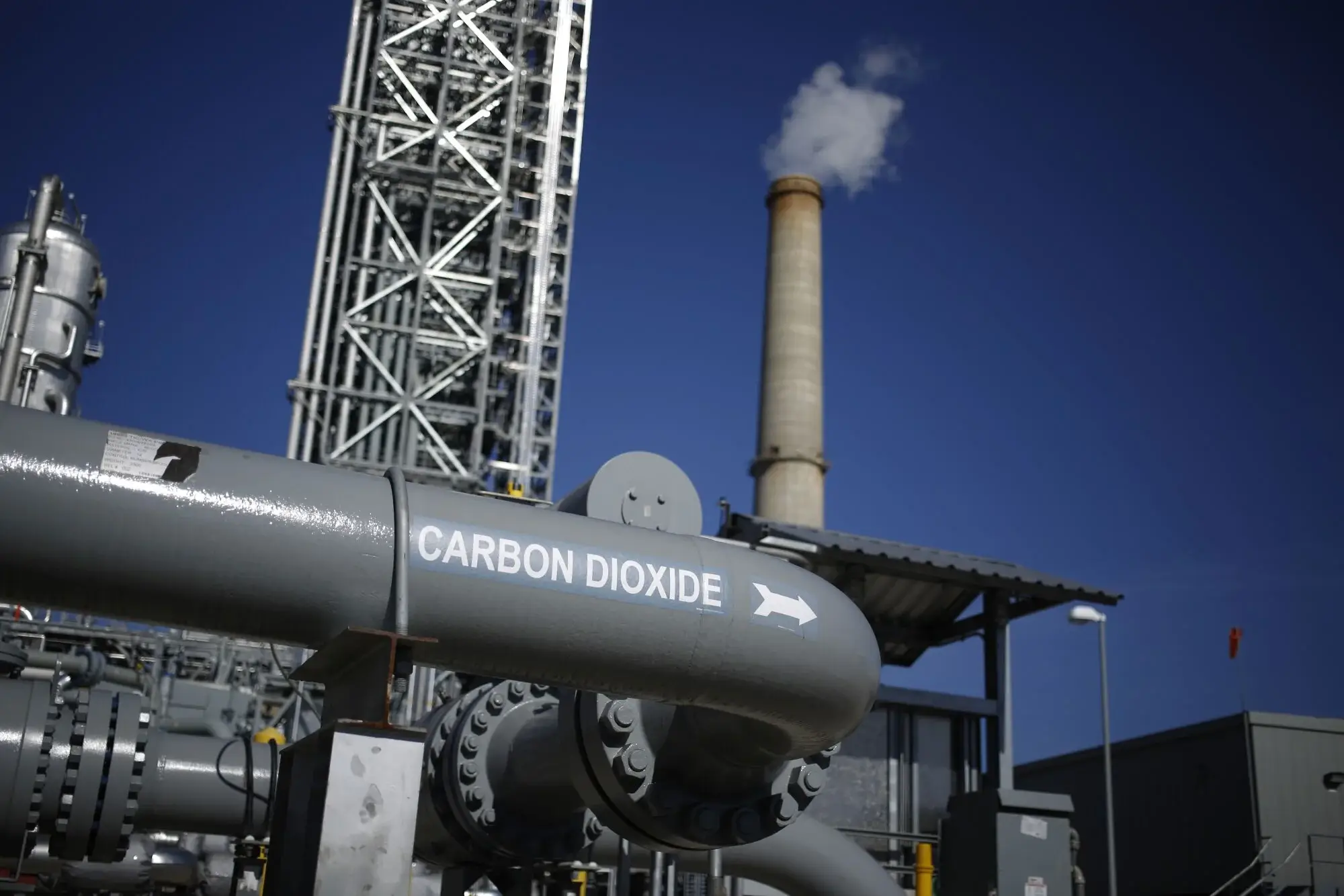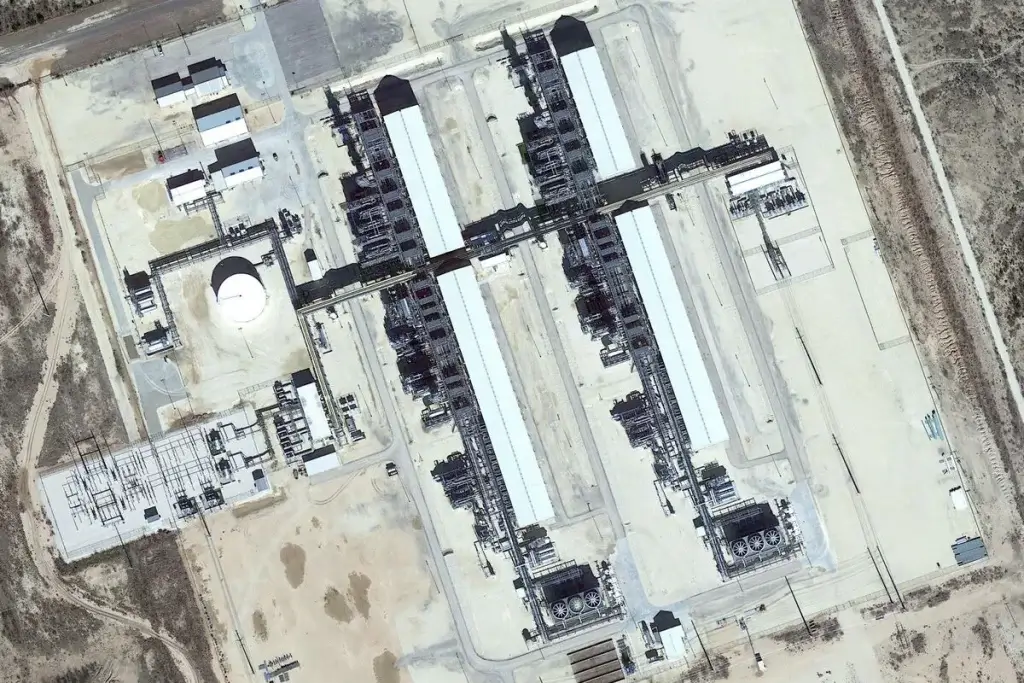An Oil Giant Quietly Ditched the World’s Biggest Carbon Capture Plant

Occidental Petroleum is leading the global charge to vastly expand the use of technologies that suck up carbon dioxide. The failure of company’s biggest-ever bet shows the challenges ahead.
By Natasha White, Akshat Rathi, and Kevin Crowley
The world wants to master the process of corralling carbon, and Occidental Petroleum Corp. is building a futuristic machine on the dusty plains of Texas designed to do just that.
The billion-dollar complex, called Stratos, will suck carbon dioxide out of the atmosphere and bury it deep underground. Amazon.com Inc., Shopify Inc., Airbus SE and the Houston Texans football team are among the businesses signed up to pay by the ton for captured carbon, long before the site is operational. US President Joe Biden is putting hundreds of millions of dollars behind the technology. Occidental Chief Executive Officer Vicki Hollub has spent $1.1 billion buying the startup behind Stratos and, after successfully lobbying for government support, intends to build 100 plants just like it. Warren Buffett, Occidental’s biggest investor, has given his tacit blessing.
This is not the first time Occidental has bet big on technology to manage carbon. A mega-plant for carbon capture and storage — a facility named Century located about 100 miles from Stratos — was built by the oil giant in 2010. At the time it was set to become the biggest-ever example of carbon capture, representing more than 20% of global capacity.
Unlike the newer technology used in Stratos, known as direct air capture (DAC), Century pulls CO2 from a dedicated source of emissions: It’s built into a natural gas processing plant. That older process is both better established and much cheaper than the newer machines built to suck CO2 from the air. There’s also the added advantage of a more direct business application, with Oxy deploying recovered CO2 from the gas plant as a tool to produce even more oil. But that older facility — with simpler tech and a production-linked incentive — has consistently failed to deliver results.
A Bloomberg Green investigation has revealed that Century never operated at more than a third of its capacity in the 13 years it’s been running. The technology worked but the economics didn’t hold up because of limited gas supplied from a nearby field, leading to disuse and eventual divestment. Oxy quietly sold off the project last year for a fraction of the build cost. It was a far cry from the fanfare the company made in the plant’s early years — and the anticipation that’s been building for Stratos.
Occidental shares fell as much as 4.7% on Monday, making it the second-worst performer in the S&P 500 index.

Occidental said the Century plant “continues to operate as designed.” A spokesperson said in an email it would be a “mischaracterization” and “false narrative” to use the plant as an example of CCS project performance.
Shortcomings have marred virtually all of carbon capture’s previous generation used for climate purposes, an assortment of a few dozen facilities around the world grouped under the acronym CCS (for carbon capture and storage). Century’s struggles show the risk of underwriting the cost of carbon capture with fossil fuel revenues. Even if the technology works, projects frequently fail when commodity prices drop.
This legacy of underperformance is a warning about relying on the next wave of carbon-wrangling tech — both newer DAC projects like Stratos and an anticipated build-out of CCS facilities like Century on a vast scale — to play the role of climate savior. Both technologies, new and old, are now being presented as ready-to-go climate solutions, in particular by the oil sector which is eyeing them as a licence to operate.
The path forward from here, according to the International Energy Agency, requires rapidly scaling up CCS worldwide. That means adding more than one Century-sized plant each month through the end of the decade, because it’s cheaper than using newer carbon-removal technologies and stops emissions from entering the atmosphere in the first place. Focusing attention on CCS and enlisting the global oil industry’s support have become an emphasis of the upcoming COP28 climate summit, with oil exporter United Arab Emirates playing host. As mid-century net-zero goals get closer, researchers anticipate vastly expanding DAC projects to draw down CO2 and keep temperatures in line with the Paris Agreement.
Malte Meinshausen, professor in climate science at the University of Melbourne and author of a landmark report on the topic from the United Nations-backed Intergovernmental Panel on Climate Change, is among those who believe we “absolutely need” carbon capture “in order to get to the lower levels of climate change we want to get to.” Like many climate-focused observers, he’s worried about just who has been empowered to handle much of the deployment.
“The problem,” Meinshausen said, “is that it has the wrong bedfellow in the fossil-fuel industry.”

The oil sector’s obsession with carbon capture has deep roots that long precede the current climate crossroads. Technology to separate CO2 from other gases dates back to the 1930s, and since the 1970s it’s been a tool in the production of oil. The last dregs in ageing fields can be sticky and need some form of lubricant. Pure CO2 is perfect for this role and became the lube of choice in a process known as enhanced oil recovery.
After decades of deployment, however, total carbon capture capacity globally is only about 45 million tons of CO2 per year. That’s just 4% of carbon capture needed by 2030 to be on track for net zero by 2050, according to the IEA. And beyond the usefulness of producing more oil, the technology has also been the beneficiary of a decade of policy incentives, including new laws from the US government to increasingly subsidize the burying of CO2. Now companies can get as much as $85 per ton.
Why hasn’t carbon capture become a more mainstream technology? To answer that question it helps to look back at Century’s shortcomings.
When Hollub was managing Oxy’s enhanced oil recovery in the Permian, she came to realize that the greatest limitation wasn’t the amount of oil in the ground but the availability of CO2. Most of the company’s supply comes from mining the gas underground, and its fields had started to run low. That same worry features prominently in the company’s shareholder disclosures to this day. Without an ample supply of CO2 at hand, yield from some fields would disappoint.
Century began to take shape in 2008 as a potential solution to this problem. Oxy announced plans to build the plant and accompanying pipeline infrastructure in partnership with SandRidge Energy Inc., another oil and gas company. The facility was designed to separate naturally existing carbon dioxide that was mixed with natural gas supplied from the nearby Pinon field.
The gas mixture entering the plant is brought to high pressure, cooled and then treated with chemicals to separate out the CO2. Oxy got to use the CO2 to help produce more fossil fuel while SandRidge got to sell the pure natural gas.
Ray Irani, Oxy’s then-CEO, expected Century to help increase the company’s Permian Basin production by 25% to about 225,000 barrels of oil equivalent a day. It would become the world’s biggest carbon capture plant, capable of processing 8.4 million tons of CO2 every year.
“Any capital-intensive project like this is not for the faint of heart,” said Todd Stevens, a former senior Oxy executive who was responsible for the deal with SandRidge. “You find out over years if you were successful.”
Century wasn’t. It never reached the projected levels of CO2 capture. From 2018 to 2022, Century captured less than 800,000 tons of CO2 each year, according to an exclusive analysis of US Environmental Protection Agency filings conducted by Data Desk, a consultancy that focuses on polluting industries. That’s less than 10% of the plant’s nameplate capacity. (Oxy didn’t comment on these figures.)
Century was built with two engines, referred to as “trains” by workers at the plant. One is capable of catching 5 million tons of CO2 and the other can handle 3.4 million tons. But only one ever ran and never at more than half its capacity, according to a former employee who asked not to be named for fear of repercussions. Recent analysis of satellite images by Data Desk shows that the cooling towers on the second train are idle, indicating it’s not in operation.
In January 2022, following a decade of struggles at the project, Oxy quietly rid itself of the asset. The sale to a subsidiary of oil magnate Malone Mitchell’s Mitchell Group was not publicly announced by Oxy before being published on a no-name basis in its annual report. Oxy secured around $200 million after investing more than four times as much in construction alone.









